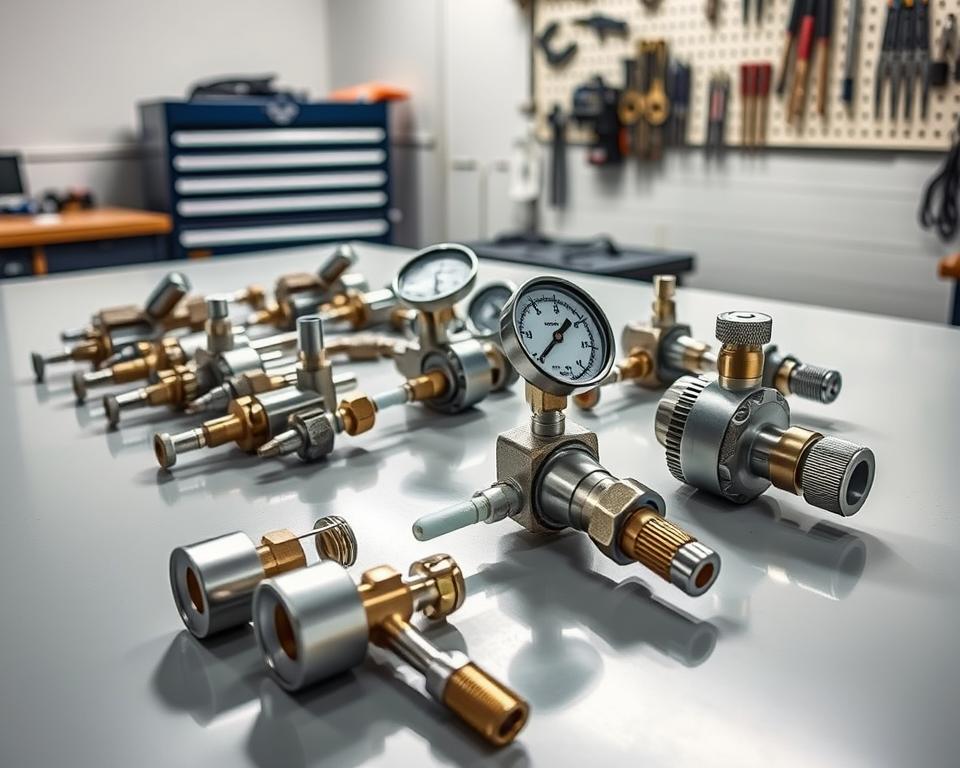CO2 Regulator Fittings – Essential Handbook & Tips
Have you realized that key regulators in CO2 systems reduce tank pressure from 800-900 psi to a more practical 10-30 psi? This not only demonstrates the capability of CO2 regulator fittings but underscores their critical role in securing a perfect pour. They play a key role in settings like kegerators, aquariums, and industrial applications. Comprehending CO2 regulator fittings is fundamental for top functionality and reliability.
CO2 regulator fittings greatly influence the excellence and palatability of carbonated refreshments. Choosing high-quality CO2 regulator fittings can preserve uniform gas pressure, avoiding excessively or insufficiently carbonated beer issues. It’s important to select high-quality CO2 fittings from trusted sources like Installation Parts Supply. This secures endurance and performance. We explore various fitting alternatives, installation advice, maintenance tips, and decision-making tactics for particular requirements.
Key Highlights
- Key regulators are essential for reducing high CO2 tank pressure for ideal serving.
- Various beer styles necessitate specialized carbonation settings to secure the best flavor.
- Steady gas pressure is imperative to prevent over or under-carbonated beverages.
- Additional regulators are essential when dispensing multiple kegs at diverse pressures.
- Opting for top-grade fittings from renowned brands can enhance system reliability.
Overview of CO2 Regulator Fittings
CO2 regulator fittings play a key role in regulating carbon dioxide flow and pressure in multiple fields. They span beverage dispensing, fish farming, and healthcare applications. They transform the CO2 pressure from a high range (800 to 1000 PSI) to a more regulated range (1 to 40 PSI). This adjustment is critical for the consistent performance of CO2-dependent devices.
The main parts of CO2 regulator fittings are the regulator and the shut-off valve. The regulator sustains desired pressure levels, while the shut-off valve offers manual gas flow control. A important safety feature is the check valve. It’s designed to prevent back-siphoning, preserving the system’s integrity. In aquatic setups, attaining stable pH levels through exact CO2 delivery is essential. Tools such as bubble monitors and pH regulators play a significant role in this process, aiding in plant health.
Choosing dependable CO2 regulator fittings is essential to efficiency in diverse environments. When selecting fittings, it’s important to consider the suitability of materials with CO2. For example, silicone tubing might allow gas to escape, which could cause losses. Choosing premium needle valves can ward off ‘end of tank dumps’ ‘end of tank dumps.’ This secures safety and upholds uniform CO2 supply.
How CO2 Regulator Fittings Operate
CO2 regulator fittings play a pivotal role in the operation and safety of CO2 systems. They ensure consistent pressure, key to proper carbonation in refreshments. High-pressure CO2 tanks, holding 800 to 900 psi, require pressure reduction to a practical 10-30 psi. This pressure drop is key to serving at the right carbonation levels. Main regulators, integral components in CO2 regulator fittings, enable this process. They frequently include a gauge or dual gauges to display the gas pressure.
Regarding serving beer, the operation of these fittings is absolutely critical. Uneven pressure may impair the excellence of the pour. This can result in beer that’s either over-carbonated or lacking carbonation. Given that distinct beer types require unique carbonation levels, like stouts demanding less carbonation than lagers, auxiliary regulators are essential. They allow for adjustments based on the specific needs of each keg.

For mobile serving, such as with smaller 74 gram CO2 tanks, mobile beer regulators are perfect. They allow serving from a small setup, perfectly dispensing a 1/4 barrel. Opting for trustworthy CO2 system fittings is critical. Examples include Taprite are well-known for consistent regulators, enhancing the brewing operation.
| Regulator Type | Pressure Range | Use Case |
|---|---|---|
| Primary Regulator | 10-30 | Used for serving standard beer styles |
| Dual Gauge Regulator | 0-60 | Shows both tank and output pressures |
| Secondary Regulator | Fluctuates | Used for pressure adjustment across several kegs |
| Mobile Beer Regulator | 10-14 | Designed for use with compact tanks |
Grasping the roles and specifications of CO2 regulator fittings can enhance a serving setup. Regularly checking pressure gauges and fittings ensures that the system works flawlessly. This diligence leads to superior service quality.
Categories of CO2 Regulator Fittings
When you’re choosing CO2 regulator fittings, it’s important to understand the varieties available for maximum efficiency in diverse scenarios. The primary categories are single gauge and dual gauge regulator fittings. Each fulfills specific roles, suiting the requirements of a range of applications from entry-level home brewing to complex industrial operations.
Single Gauge Regulator Fittings
Intended for simple operations, single gauge regulator fittings suit manual adjustment needs. They include a sole gauge showing the gas’s output pressure. Perfect for minor projects like home kegerators or small breweries, they provide ease of use over complexity. Manufacturers like Brewmaster and Fermentap are known for offering simple and efficient solutions.
Dual Gauge Regulator Fittings
Dual gauge regulator fittings are engineered to deliver more precise measurement by displaying both the output and the remaining tank pressure. They are essential to advanced operations, including commercial brewing. This dual info helps users prevent mishaps such as keg explosions or gas leaks. For those demanding higher accountability, brands like KOMOS and Taprite offer a wide selection of dual gauge options.
| Type | Benefits | Recommended Usage | Notable Brands |
|---|---|---|---|
| Single Gauge Regulator Fittings | Ease and simplicity | Domestic setups, compact systems | Brewmaster & Fermentap |
| Dual Gauge Regulator Fittings | Accurate dual readings | Advanced operations, industrial setups | KOMOS / Taprite |
Selecting the Ideal CO2 Regulator Fittings for Your Application
Choosing the right CO2 regulator fittings necessitates key factors. These considerations improve the CO2 system’s performance and safety. Initially, evaluate the pressure range that meets your application, ensuring the fittings withstand the designated pressure. You must verify compatibility with CO2 sources like CGA-320 valves for a seamless connection. Also, focus on durability to prevent leaks and malfunctions in your CO2 system.
Important Aspects in Choosing Fittings
- Pressure Range: The fittings must handle your system’s pressure demands.
- Build Quality: Opt for durable materials, such as stainless steel, for robustness.
- Fit: Confirm the fittings are matched to your CO2 sources.
- Ease of Installation: Seek out designs that make setup straightforward.
Top Brands for Superior CO2 Regulator Fittings
Prioritizing well-established brands is key for the best system performance. Installation Parts Supply is renowned for providing top-notch CO2 regulator fittings. Their offerings combine quality and cost, meeting the needs of hobbyists and professionals. The Milwaukee MA955 solenoid, costing approximately $40 CAD, is praised for its efficient operation and reliability. Additionally, the Aqualabs regulator and the Dici regulator with a bubble counter are economical, available for $50 to $60 CAD on Amazon. These brands are top picks for improving your aquarium system.
Installation Advice for CO2 Regulator Fittings
Installing CO2 regulator fittings necessitates a keen attention to minute details and observance of critical safety guidelines. An accurate installation secures that the system operates effectively. It also prevents leaks that could pose safety risks. For a secure and effective setup of CO2 regulator fittings, follow these recommendations:
- Start by verifying the emergency shut-off. Ensure it is closed before continuing with installation, as this prevents accidental gas flow during the installation process.
- Ensure correct sealing on the threaded interfaces. Teflon tape is excellent to ensure a secure fit without risk of leakage.
- Configure the CO2 regulator to the proper pressure, which is key to reaching ideal carbonation and averting system damage from high pressure.
- After completing all connections, vent the gas in sequence to allow for accurate pressure readings and ensure that any trapped air is removed from the system.
- Post-installation, inspect carefully for leaks. A soapy water solution is effective for spotting leaks, confirming a secure system.
By adhering to these installation tips, you can substantially improve both the functionality and security of your carbonation setup.
CO2 Regulator Parts: Maintenance and Troubleshooting
For optimal CO2 regulator performance, consistent upkeep and prompt problem-solving are essential. Consistent monitoring reveals issues promptly. Leak detection is critical. Soap tests reveal leaks through bubble formation.
Correctly securing internal parts is essential, with a 7/8 socket wrench suggested for optimal tightening. Maintaining component integrity prolongs lifespan. After putting the bonnet back, 75 foot/lbs of torque is recommended. A well-functioning regulator should show over 40 PSI post-repair. Occasionally, a further 1/4 turn ensures correct pressure.
Installation errors or missing washers can result in leakage, causing rapid CO2 loss. Pressure relief valves should activate under 60 PSI for beer regulators. However, there can be instances of release at higher pressures. Diaphragm or cartridge failure often necessitates regulator rebuilds.
Different brands offer varying experiences. The Milwaukee MA957, though popular, is sometimes criticized for needle valve problems and comes with a 6-month warranty. A 5-year warranty from CMBecker underscores product reliability.
Regular upkeep prolongs the life of CO2 systems. Understanding your regulator’s specifications, such as Taprite’s 0-50 PSI range, facilitates effective troubleshooting. Taprite regulators handle various beverage pressures, showcasing adaptability.
Budget CO2 Fittings vs. High-End CO2 Regulator Fittings
Choosing between affordable CO2 fittings and high-end CO2 regulator fittings hinges on their price. Basic options might start at $20, whereas top-tier products often are priced from $200. For instance, a cost-effective CO2 setup with a basic regulator attached to a standard 5 lb cylinder could cost between $150 to $175. Conversely, a premium CO2 system could reach $625, depending on brand and quality.
High-quality components are key to reliable CO2 systems. It is commonly observed that premium regulators offer exact pressure modulation, crucial for tanks smaller than 10 gallons. Furthermore, over 50% of users favor fully assembled setups, prioritizing convenience and guaranteed quality. Assembly by companies versus individual manufacturing can lead to significant price differences.
There’s potential for savings when individuals opt to buy parts separately and assemble themselves by around 20-30% relative to complete kits. There is significant price variation in components like solenoids and metering valves. Solenoids can cost between $20 and $50, while the cost of metering valves spans from $17 to beyond $200, based on quality and performance.
A 5 lb aluminum CO2 tank, costing approximately $60, adds to the overall cost. Feedback on products like the KOMOS® Premium Dual Gauge CO2 Regulator, priced at $59.99, is mixed. It has an operating pressure range up to 60 PSI and an unspecified maximum flow rate. This regulator also comes with a built-in pressure release valve activated at 65 PSI.
Regarding longevity and performance, almost 70% of users report satisfaction, with approximately 80% recommending it for homebrewing. However, around 10% of users report slow leaks. Investing extra is driven by the need for reliable performance, a key factor in selecting between economical and premium CO2 regulator fittings.
Conclusion
Choosing the right CO2 regulator fittings is essential for your system’s performance, integrity, and economic efficiency. We have outlined key considerations, including categories of CO2 regulator fittings and factors to guide your decision. Choosing the right regulator is key to achieving the proper carbonation in draft beer and maintaining reliable operation.
Premium fittings often have a higher upfront cost but provide better durability and ease of maintenance. High-quality brands like Airgas, Taprite, and Micromatic offer superior reliability. They cater to varied user requirements, ensuring durability and long-term performance.
It is recommended to consult trusted suppliers like Installation Parts Supply when setting up or upgrading a CO2 system. Access to top-notch products and expert advice can greatly improve your system’s functionality. Superior fittings represent a smart investment for both homebrewing and industrial applications.
Frequently Asked Questions
What are CO2 regulator fittings and what is their purpose?
CO2 regulator fittings manage the flow and pressure of CO2 in systems such as kegerators, aquariums, and diverse systems. They serve an important function in guaranteeing the system’s efficiency and security by controlling CO2 levels.
What are the main types of CO2 regulator fittings?
The primary types are single gauge and dual gauge regulator fittings. For simple setups like home kegerators, single gauge fittings offer basic, manual control. Alternatively, dual gauge fittings offer precise monitoring for complex or industrial systems.
What factors should I consider when choosing CO2 regulator fittings?
Selecting the right CO2 regulator fittings requires evaluating the pressure needs, fit with your CO2 supply, and build standards. Ensure high durability and safety to prevent leakage and promote optimal operation.
What are some recommended brands for high-quality CO2 fittings?
Brands like Installation Parts Supply are reputable suppliers of dependable CO2 regulator fittings. Selecting well-known brands ensures both safety and efficiency.
Can you provide installation guidelines for CO2 regulator fittings?
For successful installation, ensure all connections are tight to avoid leaks. Adjust the pressure appropriately and vent gas in order to achieve accurate readings. Refer to expert guides to improve the process.
How should I maintain my CO2 regulator fittings?
Routine care is key to keeping your system in peak condition. Regular leak inspections, pressure recalibrations, and addressing minor issues are vital. Such practices ensure your system performs optimally.
Are premium CO2 regulator fittings worth the investment?
Absolutely, premium fittings from reputable manufacturers can lead to savings by minimizing repair and replacement needs. They offer better reliability and boost your system’s overall functionality.


